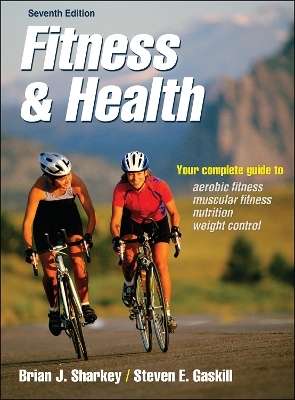
Fitness & Health
Human Kinetics (Verlag)
978-0-7360-9937-0 (ISBN)
The completely revised seventh edition of Fitness & Health offers a comprehensive understanding of the exercise–health relationship and provides a framework for attaining health and fitness goals. This one-stop handbook for students and fitness professionals explores the physiology and benefits of fitness while also providing information and tools for improving health and wellness. Authors Brian J. Sharkey and Steven E. Gaskill have 60 years of combined experience in the field, as evidenced in the depth of content and accessible style of writing. The book aims not only to educate but also to inspire the audience to put the suggested methods into practice and have a positive effect on their quality of life.
Fitness & Health, Seventh Edition, includes fresh, new content and has been restructured to enhance the educational experience:
• An entirely new chapter detailing behavior change, helping readers better understand the psychology of activity and how to modify individual behaviors using documented strategies
• A revised chapter on the physiology of fitness to help readers grasp the science behind aerobic and muscular fitness
• Proven methods for achieving aerobic and muscular fitness, plus strategies for exercising in high heat and humidity, extreme cold, high altitude, and environments with low air quality
• New information on physical activity and brain health that shows how an active life improves learning, higher-order brain processes, and academic achievement
• A detailed explanation of the Exercise is Medicine movement that highlights the benefits of regular physical activity in terms of improving quality of life and reducing health risks
Students will excel with chapter summaries of content for easier review and tables and figures that organize information for quick reference. The seventh edition also includes special elements to highlight interesting content on health and fitness, including important health behaviors, testing procedures, and proven fitness programs. In addition, instructors benefit from the inclusion of new ancillaries containing an instructor guide complete with lab activities, a test package, and a presentation package plus image bank.
With Fitness & Health, students learn the body’s response to exercise and acquire strategies for motivating themselves or others to commit to an active and healthy life. The book explains how the body responds to physical activity; why physical activity is beneficial to health; and how physical activity can help people increase aerobic and muscular fitness, achieve and maintain a healthy weight, enhance performance in work and sport, and improve vitality.
Brian J. Sharkey, PhD, has nearly 40 years of experience as a leading fitness researcher, educator, and author. Sharkey served as director of the University of Montana’s Human Performance Laboratory for many years and remains associated with the university and lab as professor emeritus. He also served as a consultant with the U.S. Forest Service in the areas of fitness, health, and work capacity. Sharkey is a fellow and past president of the American College of Sports Medicine and has served on the board of trustees. He served on the NCAA committee on competitive safeguards and medical aspects of sports, where he chaired the Sports Science and Safety subcommittee, which uses research and data on injury to improve the safety of intercollegiate athletes. Sharkey also coordinated the U.S. Ski Team Nordic Sportsmedicine Council. In 2009, Sharkey recevied the Fire Safety Award from the International Association of Wildland Firefighters. Sharkey and his wife, Anne, reside in Missoula, Montana. He enjoys hiking, paddling, cycling, and both cross-country and downhill skiing. Steven E. Gaskill, PhD, is a professor in the department of health and human performance at the University of Montana. His research interests include the relationship of physical activity to cognitive functioning in children; submaximal aerobic fitness and its relationship to work capacity and chronic disease; and long-duration work and exercise fitness as related to fitness, fatigue, immune function, and cognitive performance. Gaskill has published over 40 articles in refereed journals, presented his reasearch at numerous conferences, and authored three books. Gaskill worked for the U.S. ski team for 10 years as head coach of the Nordic combined (ski jumping and cross-country skiing) and cross-country teams and as director of the coaches’ educational programs. He has coached at three Olympic Games, and 20 skiers who have trained under him have competed in the Olympics. In 1992, the U.S. Ski Association named him the U.S. Cross-Country Coach of the Year. Gaskill enjoys backpacking, tennis, mountain biking, cross-country skiing, fishing, and mountaineering. Serious about the active life, he continues to be active year round with his wife, Kathy Sharkey and Gaskill also coauthored Sport Physiology for Coaches (Human Kinetics, 2006).
Part I. Physical Activity, Fitness, and Health
Chapter 1. Health Benefits of Activity and Fitness
Activity Reduces the Risk of Coronary Artery Disease
Activity Reduces the Risk of Chronic Diseases
Activity Increases Longevity
Summary
Chapter 2. Mental and Cognitive Health: A Sound Mind in a Sound Body
Activity Reduces Anxiety and Depression
Activity Minimizes Stress
Activity Improves Cognitive Health
Activity as a Positive Addiction
Summary
Chapter 3. Activity and Personal Health Assessment: It’s Your Responsibility
Functions of Health Screening and Early Detection
Annual Medical Examination
Cholesterol Screening
Pre-Exercise Medical Examination
Evaluating the Risks of Activity
Individual Health Risk Analysis
Summary
Part II. Turning Your Life Around
Chapter 4. Psychology of Activity: Learning to Play
Motivation
Adherence
Goal Setting
Setting Your Preference to Exertion
Summary
Chapter 5. Behavior Change: Gaining Control
Activity in Modern Society
Barriers to Physical Activity
Environment and Behavior
Stages of Behavioral Change
Behavior Modification Strategies
Positive Behavior Maintenance
Relapse Solutions
Visualization Strategies
Summary
Chapter 6. Meaningful Activity: Lifetime Vitality
Meaningful Physical Activity
Incorporating Purposeful Activity into Daily Living
Environment and Purposeful Activity
Aging and Activity
Health Habits for Longevity
Personality Attributes for Longevity
Age and Performance
Summary
Part III. Understanding Fitness
Chapter 7. Physiology of Fitness: Muscles, Energy, and Oxygen
Muscle Contractions
Energy Sources
Energy for Contractions
Supply and Support Systems
Genetic Responses to Exercise
Summary
Chapter 8. Aerobic Fitness: Stamina and Efficiency
Aerobic Exercise
Aerobic Fitness
Aerobic Training Effects
Aerobic Training and Muscle Function
Aerobic Training and Body Composition
Aerobic Training and the Skeletal System
Training Supply and Support
Specificity of Training
Aerobic Fitness Field Tests
Summary
Chapter 9. Muscular Fitness: Strength and Endurance
Muscular Strength
Muscular Endurance
Flexibility
Speed
Power
Agility and Skill
Balance
Benefits of Muscular Fitness
Strength Training Effects
Endurance Training Effects
Methods of Training
Muscle Soreness
Force–Velocity Relationship
Preload and Elastic Recoil
Core Training
Muscular Fitness Field Tests
Summary
Part IV. Improving Fitness
Chapter 10. Aerobic Fitness Training: Steps for Success
Fitness Prescription
Training Tips
Aerobic Fitness Options
Exercise Risks
Sample Aerobic Fitness Prescriptions
Summary
Chapter 11. Muscular Fitness Training: Lifetime Mobility
Muscular Strength Fitness Prescription
Muscular Endurance Fitness Prescription
Sample Muscular Fitness Prescriptions
Summary
Part V. Activity and Weight Control
Chapter 12. Energy and Nutrition: Fuel for the Active Life
Nutrients
Dietary Guidelines
Energy Intake
Energy Expenditure
Calculating Caloric Intake
Estimating Caloric Expenditure
Diet and Performance
Summary
Chapter 13. Weight Control: More Than Calories Count
Overweight and Obesity
Measuring Body Fat
Ideal Body Weight
Activity and Weight Control
Exercise Prescription for Weight Control
Adopting a Healthy Diet
Weight-Control Fallacies
Sensible Weight Gain
Summary
Part VI. Performance
Chapter 14. Training: Athletic Performance
Training Principles
Training Fallacies
Designing Your Training Program
Periodizing Your Training Program
Psychology of Performance
Overtraining
Cross-Training
Fitness and Work
Summary
Chapter 15. Environment: Acclimate, Then Perform
Regulating Temperature
Exercising in the Heat
Exercising in the Cold
Exercising at Altitude
Avoiding the Effects of Air Pollution
Summary
| Verlagsort | Champaign, IL |
|---|---|
| Sprache | englisch |
| Maße | 216 x 279 mm |
| Gewicht | 1247 g |
| Themenwelt | Sachbuch/Ratgeber ► Gesundheit / Leben / Psychologie |
| Weitere Fachgebiete ► Sportwissenschaft | |
| ISBN-10 | 0-7360-9937-9 / 0736099379 |
| ISBN-13 | 978-0-7360-9937-0 / 9780736099370 |
| Zustand | Neuware |
| Haben Sie eine Frage zum Produkt? |
aus dem Bereich


